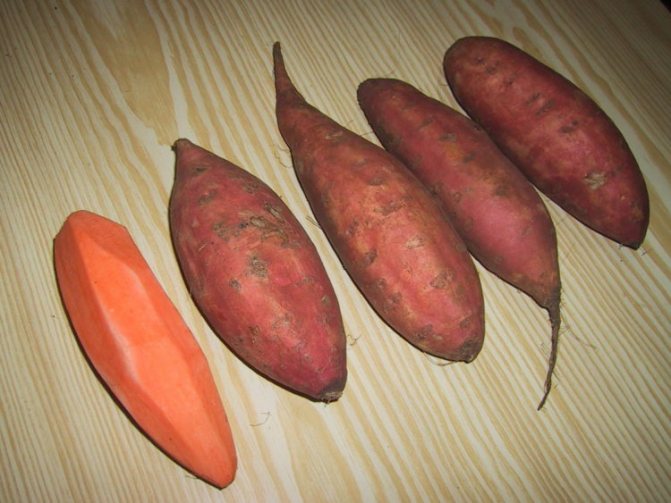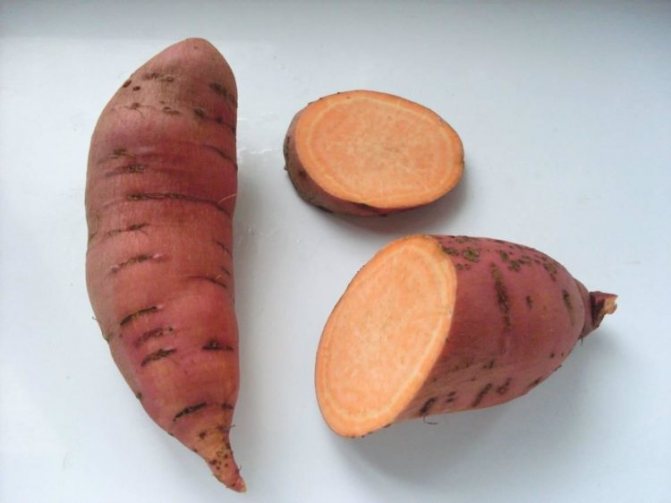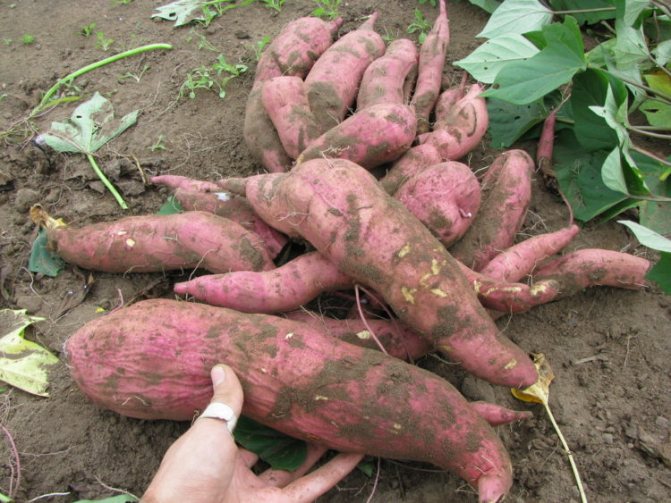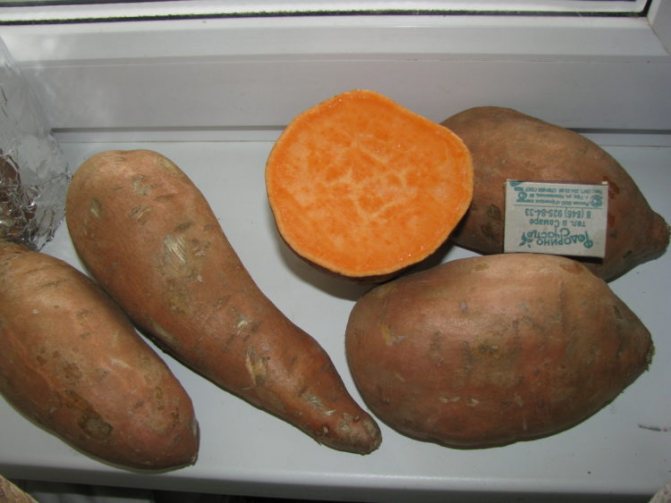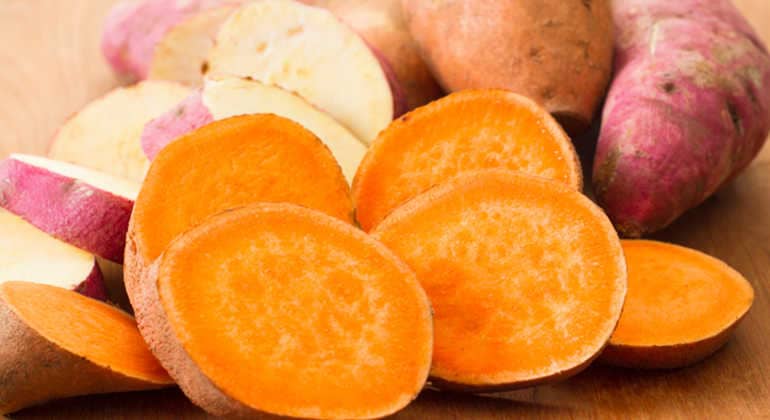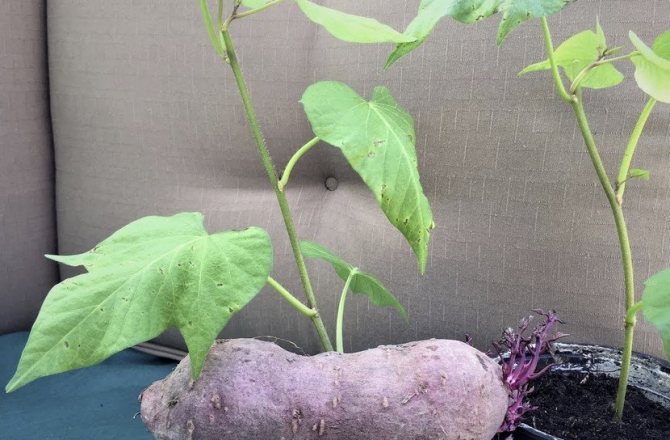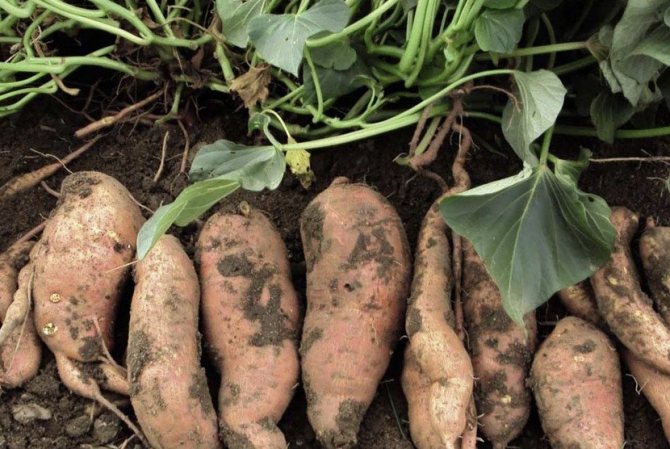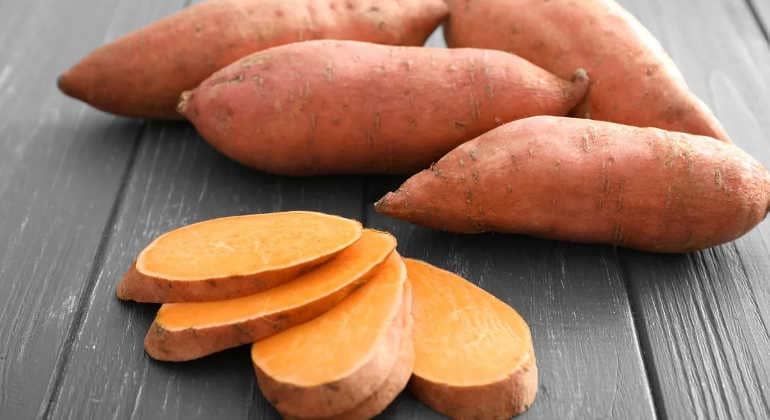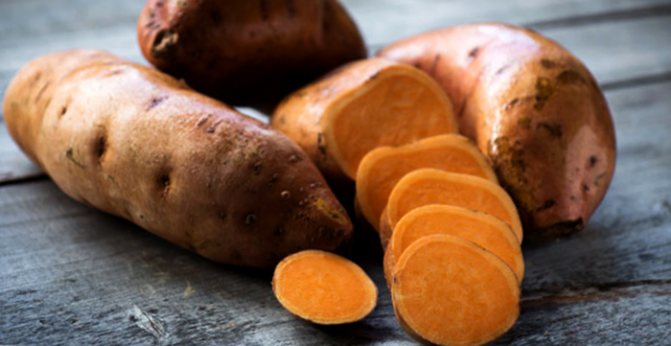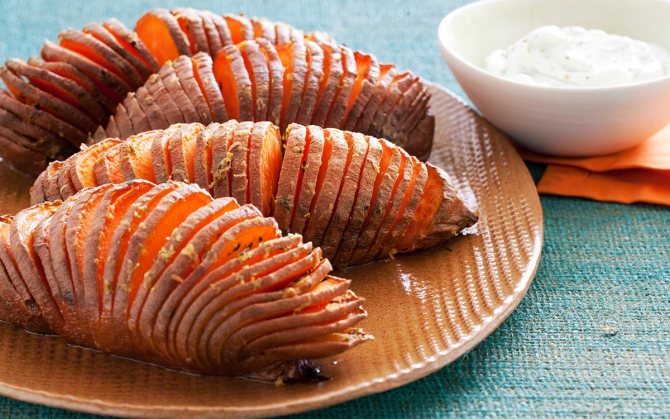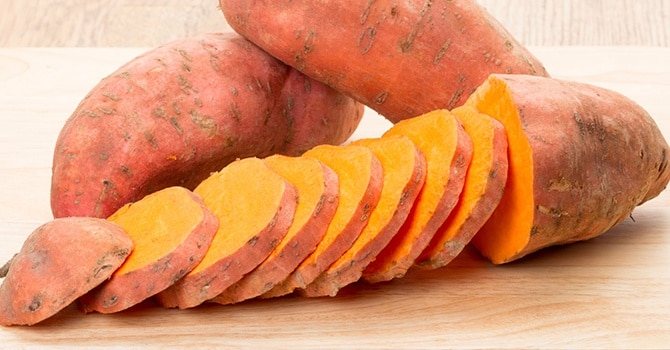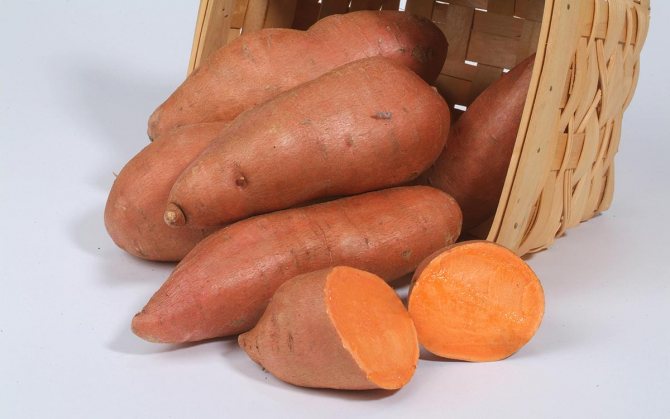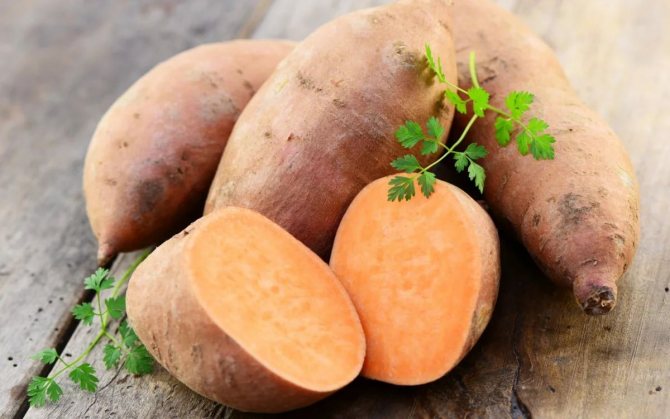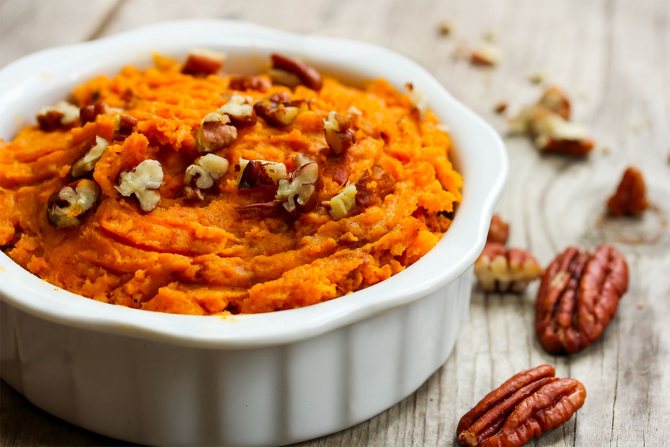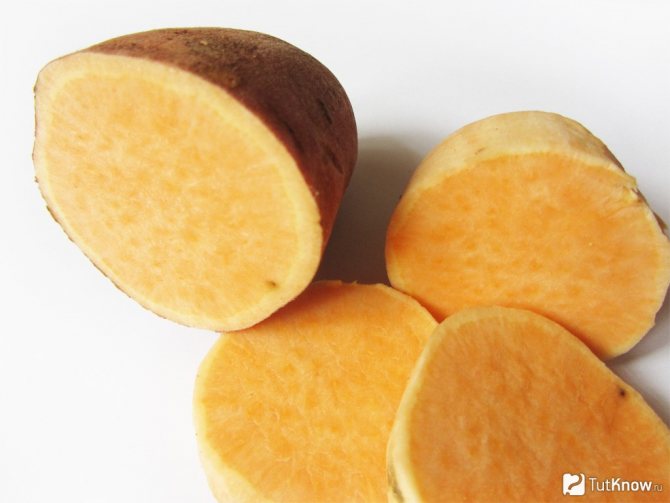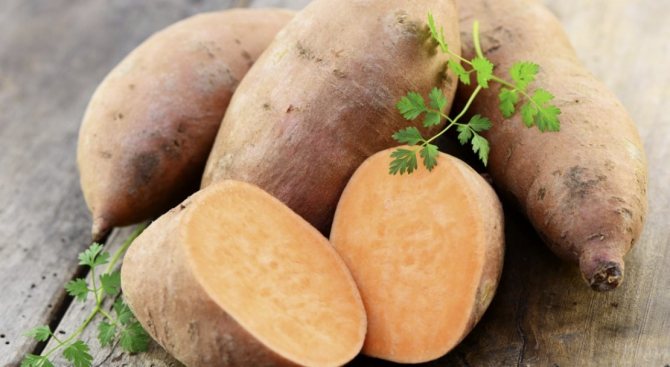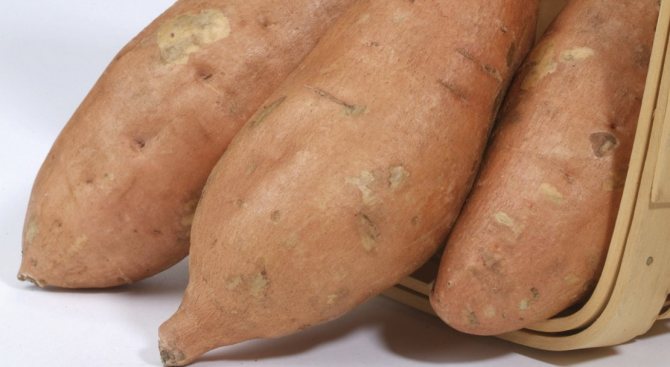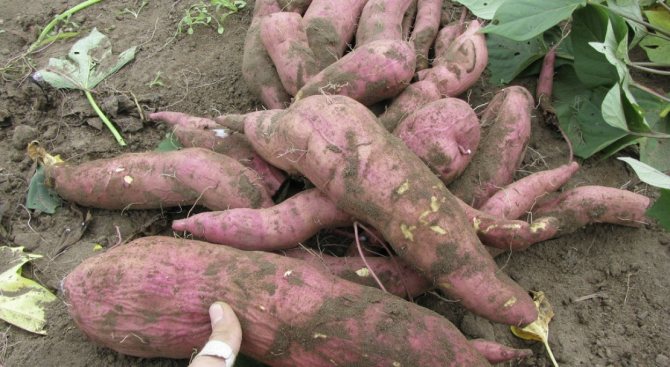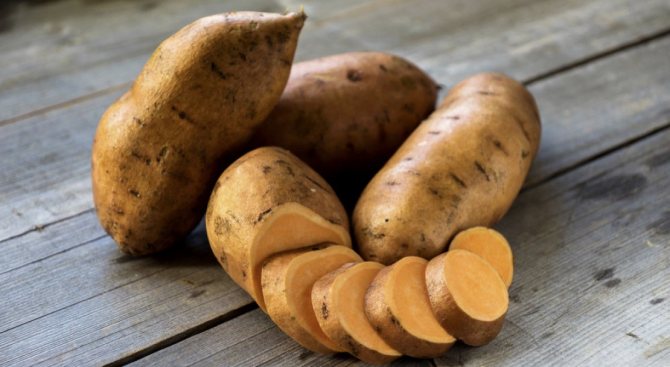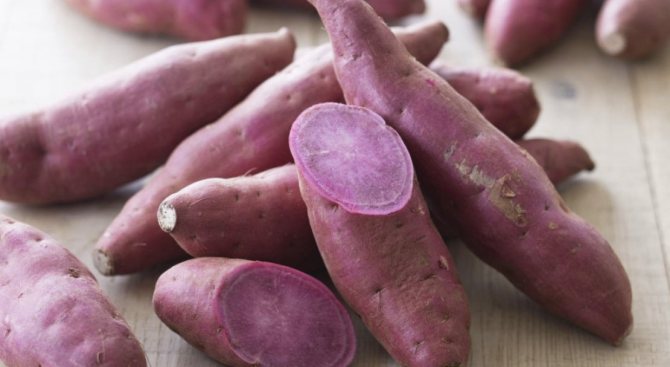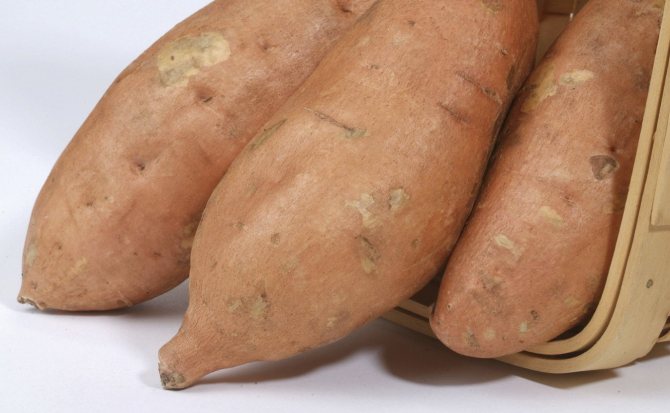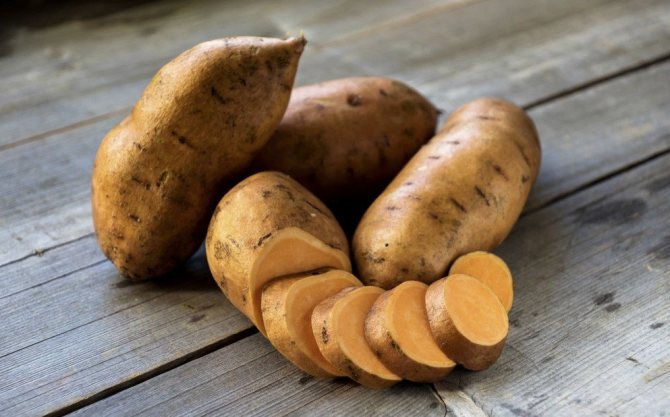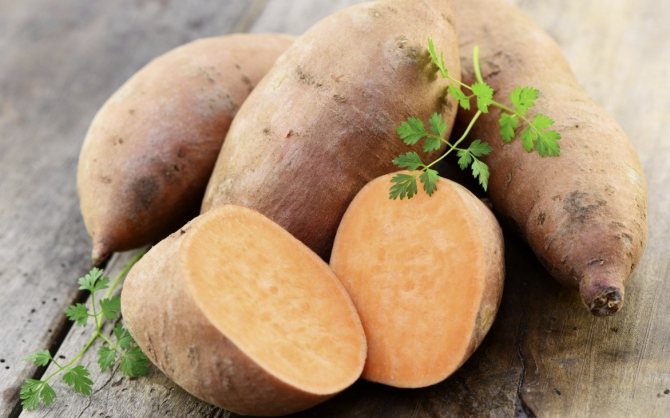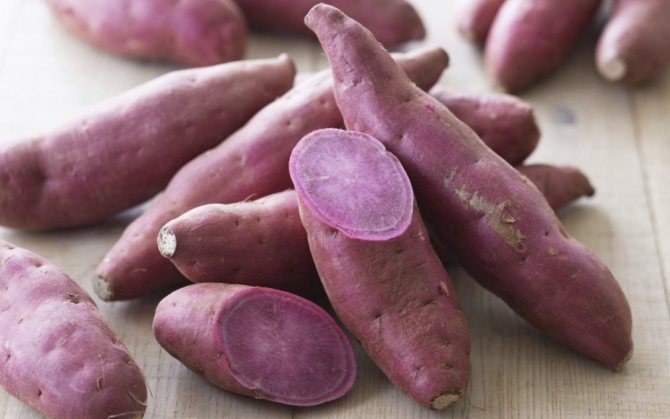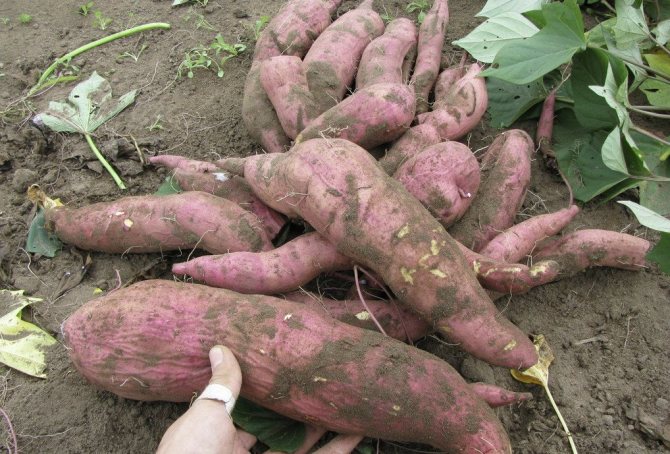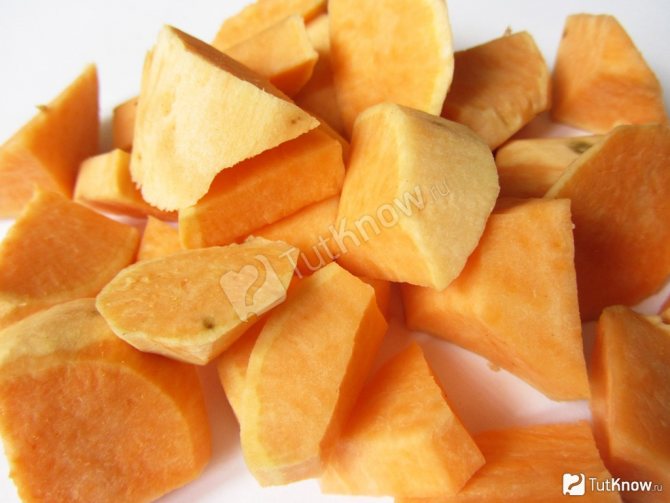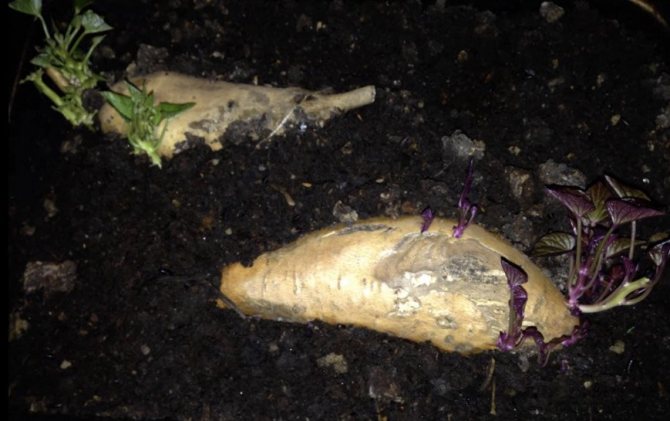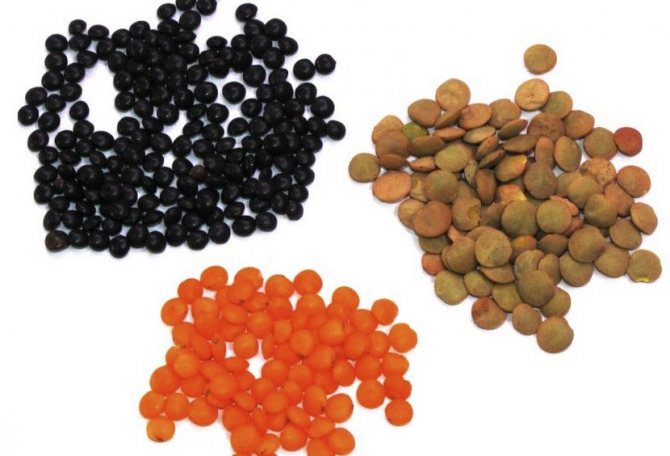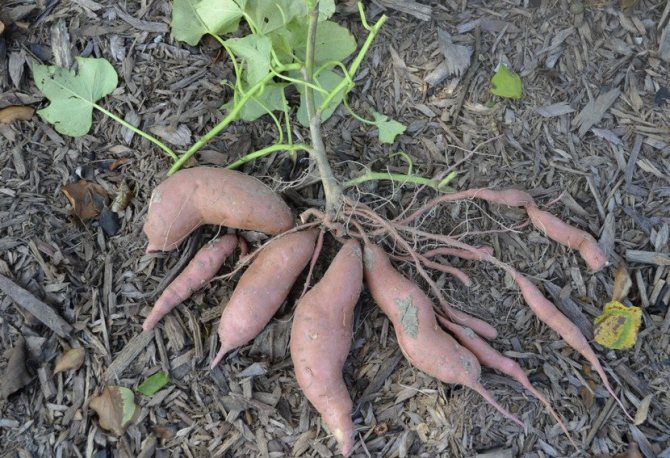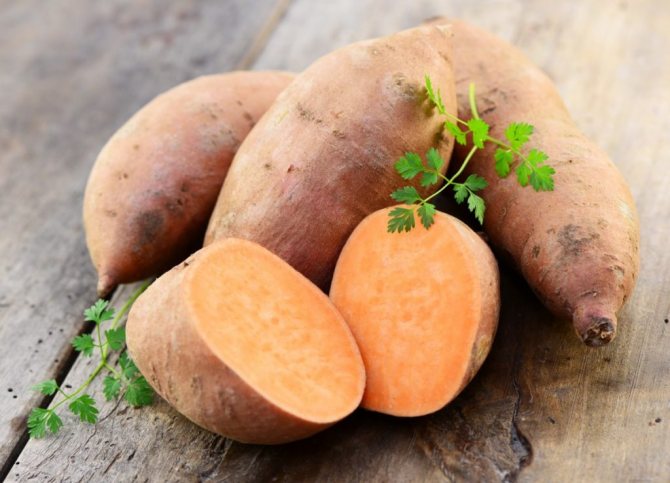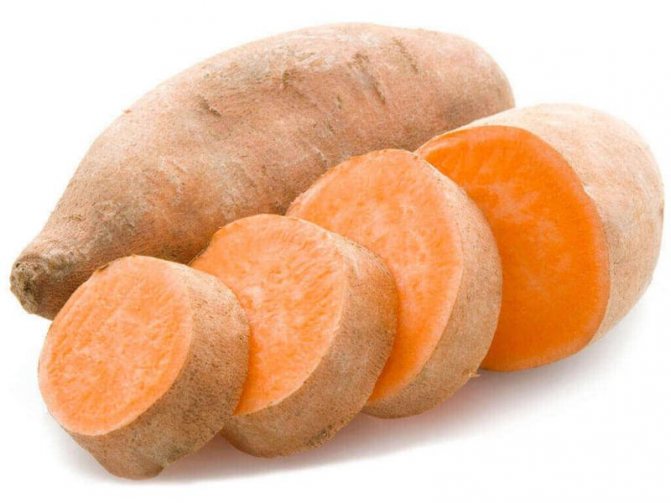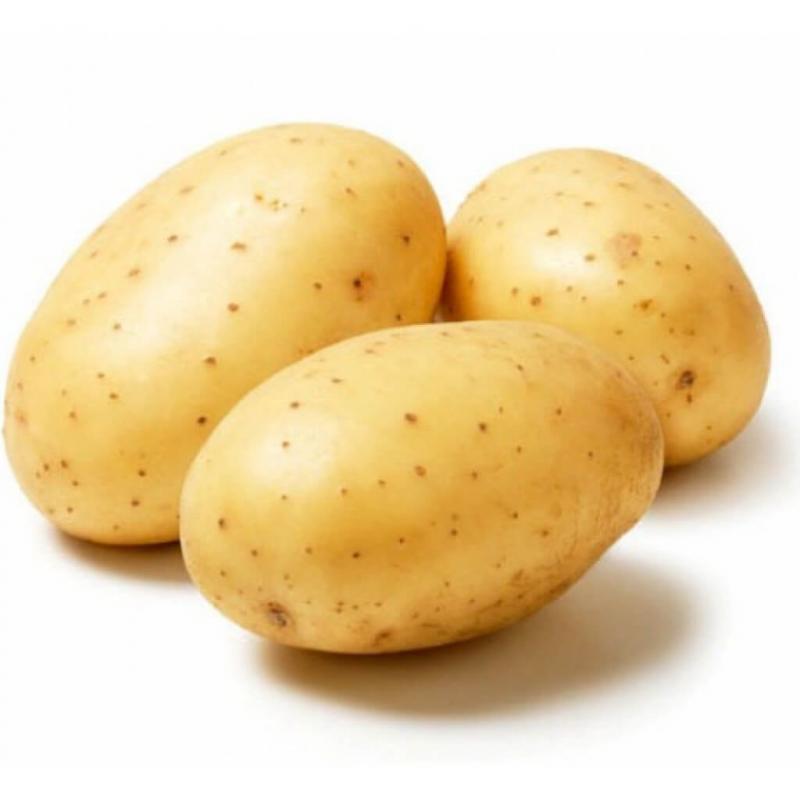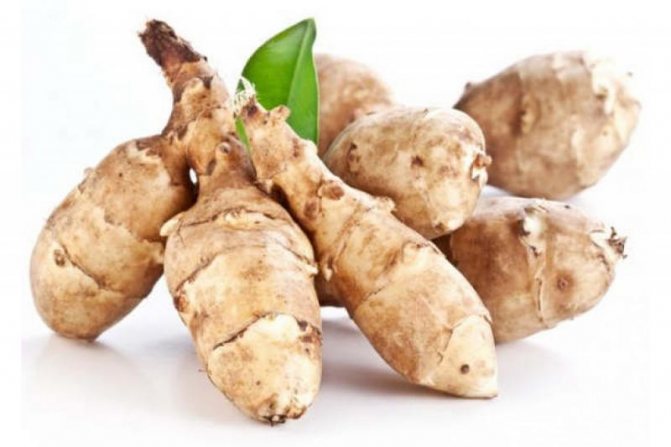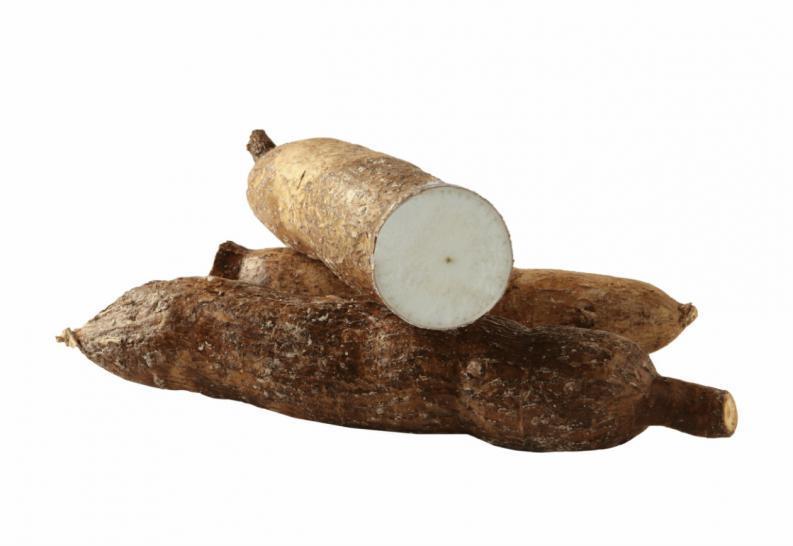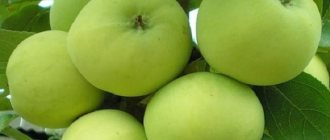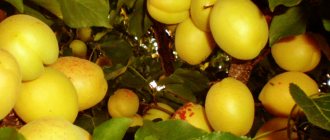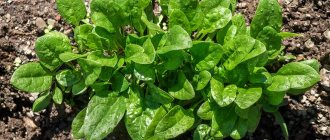Description
What it is?
Sweet potato is a tuber plant of the Ipomoea genus from the Bindweed family. Valuable food and forage crop.
"Sweet potato" and other names for the root vegetable
The name "sweet potato" was derived from the taste of sweet potatoes, which are rich in sucrose, fructose and glucose. The name of the sweet potato "kamotli", borrowed from the Spanish language, is rarely found, the names "chumara", "kumara", "kumal", taken from the Aztec language, and "achies", borrowed from the native language.
What does the root tuber look like, its photo
Sweet potato is a herbaceous vine... The stems of the plant are represented by creeping lashes from 1 to 6 meters long, rooting at the nodes. The total height of the bush ranges from 10 to 18 meters. The root system is represented by white long roots, thickening and forming edible tubers of various colors, having white, orange, cream, purple, yellow, scarlet dense pulp. The weight of one tuber is 0.2-5 kilograms.
Botanical description
The sweet potato belongs to the bindweed family. All parts of the plant are suitable for food. The tuber is up to 30 centimeters long, has a tender, fleshy juicy pulp with a thin skin. Not all varieties bloom. Cross pollination, the main pollinators are bees. Flowering in the temperate zone is rare. The plant is warm and light-requiring.
Structure
The tuber shape can be round or spindle-shaped, and the taste ranges from bland to very sweet. The texture of the pulp ranges from soft and juicy to dry, firm... When the tuber breaks, milky juice is released from it. Sweet potato tubers do not have eyes, and sprouts develop from hidden buds.
- The flowers of the plant develop from the axils of the leaves, have a large funnel-shaped corolla of pink, pale pink or white color.
- Leaves are cordate or lobed-palmate, have long petioles, bright green in color.
- The fruit is represented by a four-seeded capsule.
- Seeds are medium in size, from 3 to 5 millimeters, are brown or black in color.
What is sweet potato: photo, description, a little history
The homeland of the plant is the tropical regions of America. The name is borrowed from the language of the Indians who grew it for 5000 years before the arrival of the colonists. The Europeans learned about it thanks to Columbus.
The edible part is sweetish starchy tubers. Their length reaches 30 cm. They have tender juicy pulp and thin skin. In the tropics, the weight of one specimen reaches 10 kg. Those that we sell are not much larger than potatoes. The surface is smooth. The lack of eyes is a nice bonus.
Tubers of different varieties differ in shape, pulp color. Most of them are sweet, but there are also fresh ones. The taste was somewhat reminiscent of a turnip.
The sweet potato is common all over the world. The largest manufacturers are China, USA, Honduras, Israel. There are 6,000 varieties of sweet potatoes in the world.
Tubers came to Russia at the end of the 19th century. The first beds appeared on the Black Sea coast of the Caucasus during the Soviet era. The scientists of the All-Union Institute of Plant Industry in Sukhumi were engaged in the breeding of hybrid varieties.
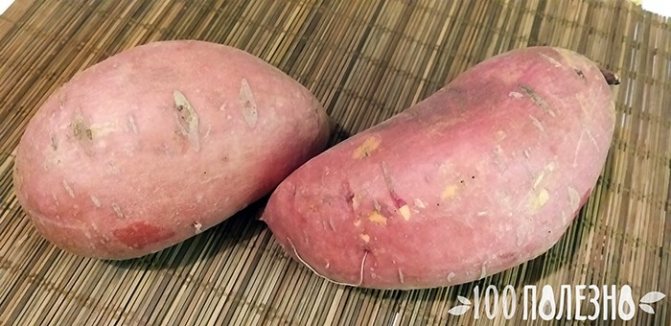
The work was carried out under the guidance of the outstanding scientist N.I. Vavilov.By the 1930s, the country possessed hundreds of hectares of varietal sweet potatoes. Today vegetables are successfully grown near Voronezh, Primorye, Khakassia and Bashkortostan. There are varieties that are even adapted to the conditions of Siberia.
But the price of sweet potatoes is an order of magnitude higher than potatoes. This is due to the excess of demand over supply, and not at all with the difficulties of agricultural technology. Any amateur gardener can get a harvest. A variety of varieties, an abundance of covering materials reduce labor costs to a minimum.
Distribution in Russia: how and where does it grow?
On Russian territory sweet potatoes are grown in Bashkortostan, Primorsky Krai and Khakassia according to the industrial scheme (growing tubers for a month in a warm room, followed by transplanting into open ground in the first half of June, after the frosts have passed). With such a planting, 4 months after planting the cuttings, it is possible to achieve the same yield as in countries with a warm climate.
Reference! Also in Russia, sweet potatoes are grown by the method of covering the soil with a film, which makes it possible to accelerate the ripening of the crop and compensate for temperature extremes.
Safety and contraindications
In rare cases, when using sweet potatoes, a number of side effects may occur, which include:
- The formation of stones in the lumen of the urinary tract. The plant contains calcium salts, which increase the risk of calculus formation. Care must be taken when including a plant in the presence of urolithiasis or a burdened family history of this disease.
- Allergic reactions. They are characterized by a mild course. Allergies associated with the consumption of sweet potatoes can occur if you are allergic to other members of the Bindweed family.
Sweet potatoes are allowed to be consumed during pregnancy (in the absence of the above contraindications). It contains a number of vitamins that are essential for the proper growth and development of the fetus. American scientists have shown that a deficiency of vitamin A, which is abundant in sweet potato pulp, increases the risk of adverse pregnancy outcomes.
Differences between "sweet potatoes" and ordinary
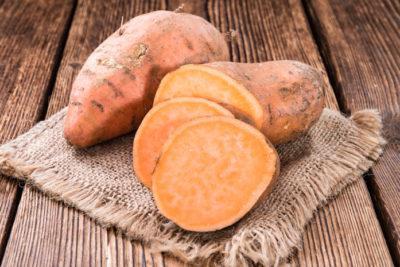

Unlike potatoes, sweet potatoes are not affected by the Colorado potato beetle.- The calorie content of sweet potatoes is 2-3 times higher than the calorie content of potatoes.
- Sweet potatoes contain six times more potassium than potatoes.
- Sweet potatoes have 4 times more carbohydrates than potatoes, which is why it tastes sweet.
- Sweet potatoes do not increase the glycemic index (relatively safe for diabetes mellitus), unlike potatoes, which are not recommended for food for this disease.
- The sweet potato belongs to the bindweed crops, the potato to the nightshade.
Learn more about the differences between sweet potatoes and potatoes here.
Sweet Potato Recipes
One of the easiest and quickest sweet potato dishes to prepare is cream soup. The tuber must first be peeled (the resulting slices are useful for frying chips), then cut into small pieces and boiled in water without salt. After that, the boiled sweet potatoes are placed in a blender and mixed with the broth. Slice chips are fried in oil and added to the soup before serving.
An interesting combination is pumpkin and orange sweet potato puree - both vegetables have a similar texture and the same cooking time, so they can be successfully combined. In turn, purple sweet potatoes go well with black rice and beets. Due to its ability to color the dough purple, purple sweet potato flour is also used in baking desserts.
Sweet potatoes in the oven and microwave
You can bake the sweet potatoes in the oven or microwave. In the first case, each tuber is wrapped in foil (herbs, spices and coconut oil can be added beforehand) and placed in an oven preheated to 200-220 degrees.Usually the baking time is at least 30-60 minutes - but if you pre-cut the sweet potato, it will bake faster.
In the microwave, sweet potatoes can be baked in just 10 minutes. First, it is thoroughly washed, peeled, several deep punctures are made and wrapped in parchment paper (recall that you cannot use foil for a microwave oven). Before serving, the baked sweet potato is cut into small pieces, salted and spices are added.
***
The sweet potato is a perennial vine plant that is only a distant relative of the regular potato. Despite the fact that it is often believed that sweet potatoes have a low glycemic index, in reality, the GI depends on the way it is cooked and eaten - when fried in oil, it can reach 90 units or more. The most beneficial types are orange (rich in vitamin A) and purple (rich in antioxidants).
Scientific sources:
- Nutrition facts and Information for Sweet potato, raw, unprepared, source
- Nutrition facts and Information for Potato, flesh and skin, raw, source
- Relationship between Processing Method and the Glycemic Indices of Ten Sweet Potato, source
Brief history of origin and country of origin of food and ornamental varieties
The use of sweet potato for food as a medicinal plant was recorded in the writings of the Aztecs. Much later, the plant was cultivated from wild and ornamental varieties in the middle of the sixteenth century in Central America (Peru), from where sweet potatoes spread throughout Europe, dividing into edible and ornamental varieties.
Thanks to numerous experiments, breeders managed to bring out unpretentious varieties of sweet potatoes. with the largest tubers, which later began to be grown in countries not only with warm, but also temperate climates.
Fried sweet potato
Another delicious way to make sweet potatoes is to fry the vegetable. This method will not be to the liking of those losing weight, but fried sweet potatoes are delicious. Cut the vegetable into cubes and fry over medium heat until cooked through, stirring constantly. The undoubted plus of sweet potato is that it is cooked much faster than potatoes. The vegetable goes well with orange zest, lemon juice, curry and pepper.
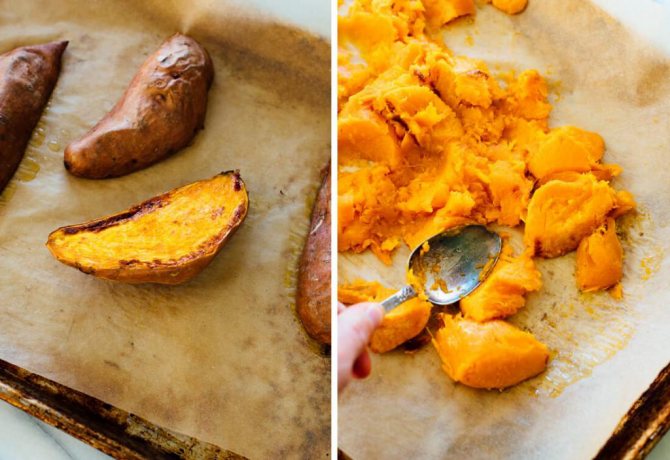

Chemical composition: how is it useful?
Per 100 g of product:
- calorie content - 86 kcal;
- proteins - 1.5 g;
- fats - 0.5 g;
- carbohydrates - 25 g (of which starch - 13 g);
- dietary fiber - 3 g; water - 78 g.
Vitamins:
- vitamin A - 800 mcg;
- ascorbic acid - 2.5 mg;
- thiamine - 0.080 mg;
- riboflavin - 0.07 mg;
- pyridoxine - 0.3 mg;
- folic acid - 15 mcg;
- vitamin K - 2 mcg.
Trace elements:
- iron - 0.7 mg;
- magnesium - 32 mg;
- phosphorus - 48 mg;
- calcium - 32 mg;
- potassium - 337 mg;
- sodium - 55 mg;
- zinc - 0.3 mg;
- selenium - 0.6 mcg.
Nutritional value and calorie content
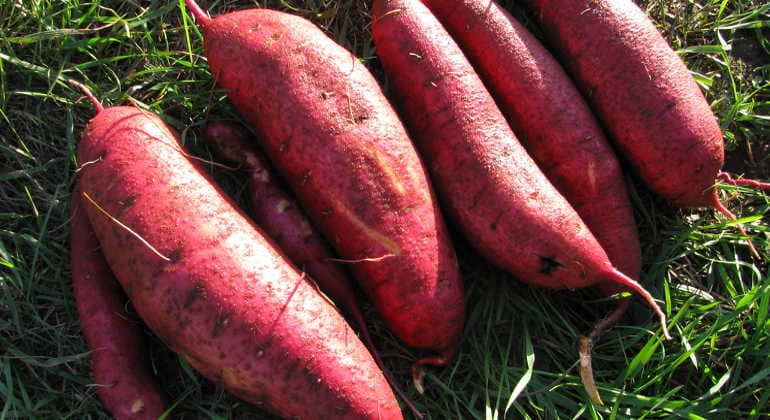

Sweet potato flavor is due to sucrose, glucose and fructose. The water content depends on the variety, climate, growing conditions (77% on average). Sweet tubers are a healthy alternative to regular potatoes.
Nutrients that make up sweet potatoes:
| Ingredients | Weight in gr. per 100 gr. root tubers |
| Protein | 1,57-2 |
| Fats | 0,1 |
| Carbohydrates | 20-24 |
| Starch | 12,65 |
The calorie content of sweet potatoes is 85-111 kcal. The exact indicator of energy value depends on the variety. Most of the calories come from carbohydrates (about 20% by weight). Among the substances of this class, sucrose is about 4 grams. per 100 gr. tubers. The contribution of proteins and fats to the energy value is only 2%.
The glycemic load shows the carbohydrate content per 100 grams. product, which is important for determining the effect on blood glucose levels. The value for sweet tubers is in the 11-12 range. The glycemic index of sweet potatoes is 50, and that of regular potatoes is 65.
Vitamin and mineral composition
Sweet potatoes contain substances that have no nutritional value, but are vital for the human body. For example, the mass of dietary fiber is 100 grams. the product is 3-4.18 gr.
The amount of vitamins per 100 gr. tubers without peel:
| Nutrient designation | Weight (in% of the daily allowance for adults) |
| BUT | 1.4 mg (90) |
| IN 1 | 0.078 mg |
| AT 2 | 0.061 mg |
| IN 3 | 0.557 mg |
| AT 5 | 0.8 mg (13.8) |
| AT 6 | 0.209 mg (13.5) |
| AT 9 | 11 mcg |
| FROM | 30 mg (30) |
| E | 260 μg (38) |
| TO | 23 μg (33) |
| Beta carotene | 8.6 mg (80) |
Orange sweet potatoes are rich in beta-carotene.By the amount of vitamin A precursor in the body, such tubers "catch up" with carrots. Purple sweet potato contains the plant pigments anthocyanins. These are antioxidants that reduce the risk of cancer, cardiovascular and eye diseases.
Sweet potatoes do not form solanine, a poisonous alkaloid found in nightshade and green potatoes.
Sweet tubers are rich in minerals. Potassium in the composition of 413 mg, which corresponds to 10.3% of the daily requirement of an adult. Corresponding indicators for copper - 0.16 mg (12.8%), zinc - 0.9 mg (10.6%).
Sweet potato contains other macro- and microelements:
- calcium;
- magnesium;
- phosphorus;
- manganese;
- iron;
- selenium.
There is more iron and calcium in sweet tubers than in regular potatoes.
Benefit and harm
Benefits of sweet potato:
- fast saturation of the body;
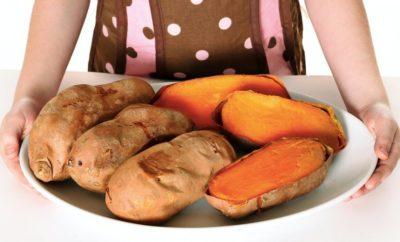

replenishment of the lack of vitamins and minerals;- improving memory due to the action of B vitamins;
- prevention of anemia due to folic acid;
- improved night vision (vitamin A);
- strengthening the blood vessels of the heart and improving blood clotting;
- improving mood, prevention of depression.
Attention! The harm of sweet potato is manifested in the predominance of sugars in its composition, which, if consumed regularly, can lead to weight gain, despite the low calorie content of the product.
We suggest you watch a video about the benefits of sweet potatoes:
Uniform sweet potato
And there is also a dish, the preparation of which will take only 8 minutes, and will be a real salvation when you need to eat quickly and healthily and feed your loved ones. Such a side dish rich in beta-carotene will only have a beneficial effect on the body of both children and adults. The method of preparation is as follows: wrap unpeeled root vegetables in foil, put on a baking sheet and send to the oven at 250 degrees, until completely softened, usually this process takes 15-17 minutes.
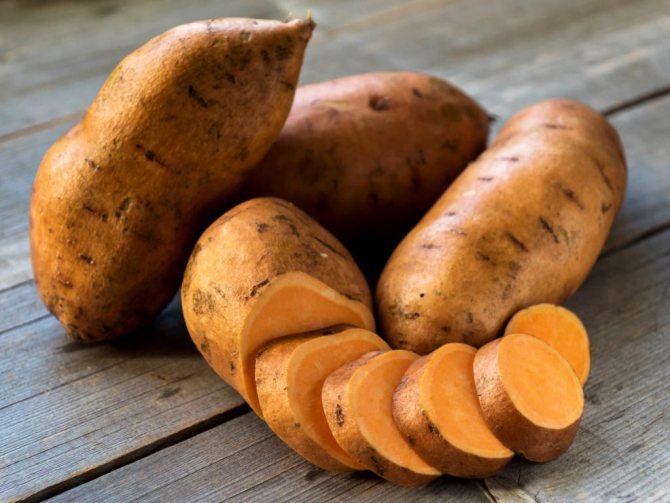

Vegetable treatment
Sweet potato is used in folk medicine for treatment and prevention.:
- heart disease, atherosclerosis, high blood pressure;
- to increase immunity and as a general tonic;
- with diseases of the gallbladder and kidneys;
- effectively used for exacerbation of gastritis and peptic ulcer disease;
- as a prophylaxis of oncological diseases;
- with intolerance to fiber (beets, carrots), sweet potatoes are also eaten;
- tubers are useful for insomnia, depression and neurosis (potassium in the composition exhibits antidepressant properties).
Does sweet potato have medicinal properties?
It has long been proven that sweet potatoes have a positive effect on the human body and help fight:
- asthma;
- bronchitis;
- flu;
- viral diseases that are transmitted by airborne droplets;
- nasal congestion;
- colds;
- arthritis;
- stress;
- high blood pressure;
- insomnia;
- stomach ulcer;
- gastritis;
- joint pain;
- neuroses;
- certain eye diseases;
- chronic fatigue;
- climacteric syndrome;
- some diseases of the gastrointestinal tract;
- various forms of cancer (stomach cancer, prostate cancer, oral cancer, esophageal cancer, bowel cancer, lung cancer);
- dehydration;
- constipation;
- high acidity;
- internal inflammatory processes;
- being overweight.
Sweet potato strengthens the immune system, reliably protects the body from free radicals and saturates it with useful substances.
Contraindications and harm
Although sweet potatoes have a beneficial effect on our body and are a storehouse of nutrients, in some cases, experts advise to stop eating it. Sweet potatoes should not be introduced into your diet for people who have been diagnosed with the following diseases:
✘ duodenal ulcer;
✘ diverticulosis;
✘ ulcerative colitis;
✘ spastic stomach ulcer;
✘ certain problems with the genitourinary system;
✘ diverticulitis.
Pregnant women should avoid eating sweet potatoes, as it can negatively affect the health of the unborn child. You should not eat sweet potatoes and lactating moms.
Individual intolerance to sweet potatoes or individual substances that make up its composition is another reason to stop using this product. If you are just starting your acquaintance with sweet potatoes, then first carefully read the popular methods of cooking this vegetable. Only combine it with foods you already know and have tried.
If after taking sweet potatoes you develop a rash on your face and body, nausea or vomiting, then you need to give up the sweet potato, since your body does not accept it. If after a while your condition does not return to normal, then immediately seek help from a specialist.
Only fresh sweet potatoes can be eaten. Rotten sweet potatoes should never be eaten as they can cause serious harm to your body.
The optimum temperature for storing sweet potatoes is 16 ° C, and the permissible humidity is 45 to 85%. If the temperature is lower, the tubers will start to rot and quickly deteriorate. If the temperature is higher, then the fruits will begin to germinate. Although in sprouted sweet potato tubers, unlike ordinary potatoes, pathogenic toxic substances are not formed, experts still do not recommend eating them.
To only benefit your body, sweet potatoes need to be stored in wooden or plastic containers or crates. If you want to increase the shelf life, then wrap the sweet potatoes in paper, sprinkle them with sawdust, dry sand or straw.
If you find an error, please select a piece of text and press Ctrl + Enter.
Varieties and types
| Variety and its short description | Dry meaty (table) | Juicy meaty (dessert) |
| Mid-season | "Red Sukhumi", domestic. Tubers are small, dense, stored for a long time. | Garnet. USA. Pink tubers, crispy flesh. |
| "Druzhkovsky", domestic. Abundant flowering. Unpretentious. High productivity. Long-term storage. | Beauregard. USA. The tubers are orange and contain a lot of carotene. The taste is reminiscent of apricot. Subject to long-term storage. | |
| Early ripening | "Vinnytsia pink". Domestic. Frost resistant. Chunky bush, deep tubers. Demanding for accurate digging. The tubers are light purple, the flesh is white and very juicy. It tastes like a potato. | "Victory-100", domestic. Tubers are medium in size, aligned, pink-orange. The taste is reminiscent of nut and banana. Not subject to long-term storage. |
| Late | "Red ginseng". USA. Has a rich red color, the stems of the plant are purple. The pulp is white. The tubers are not compact, but over a large extent. | Late. USA. "Muscat" and its subspecies "Caramel", "Egyptian", "Sukhum white". The tubers are yellow, the flesh is crispy with a nutmeg aroma. |
Decorative varieties:
- Belva;
- Ruby Carolina;
- "O.Henry".
Harvesting and storage times
Compared to potatoes, sweet potatoes mature for a long time, on average 3-4 months. Harvesting usually takes place in September-October, after the first cold autumn. The procedure is best done in sunny weather. The tubers are quite fragile, so you need to remove them carefully using a pitchfork. The dug tubers are dried and sorted.
Only undamaged tubers are stored, others are allowed for processing. The tubers that will be stored are not washed, but kept in a warm, humid room (with a temperature of + 28 ... + 32 ° C). Then they are folded into wooden or plastic boxes, wrapped in paper or sprinkled with sawdust, and stored in a dry, dark place at a temperature of + 10 ... + 20 ° C.
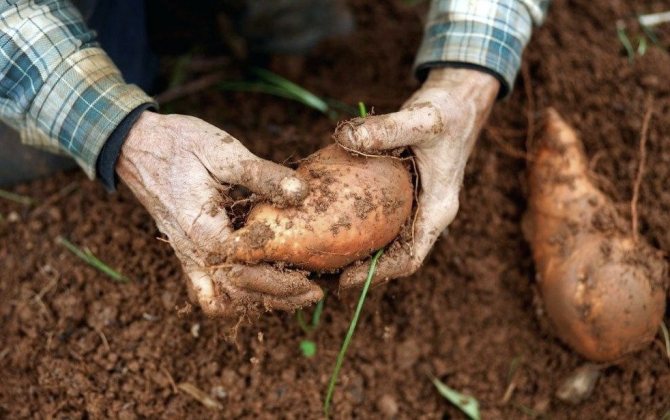

Landing
Planting time - late May, early June. The optimum temperature is 25-30 degrees. In the temperate zone, sweet potatoes are grown as an annual crop.For sowing, tubers with a length of 20-30 cm from the last harvest are mainly used, which are planted in seedling beds in greenhouse conditions, or in film beds.
Long cuttings grow from tubers in 5-6 weeksthat are cut and used for fresh planting.
Cultivation and yield
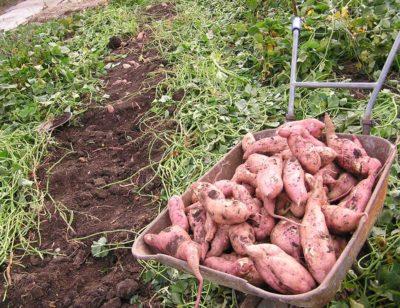

Planting of cuttings is carried out by a special planting machine, or manually at a distance of at least half a meter between the seedlings.- The distance between the rows should be at least 40-60 centimeters.
- Cuttings do not need to be rooted, rooting occurs naturally in 1-2 days.
- In the first 2 months of the growing season, the soil is kept moist. Loosening of the soil and removal of weeds is carried out at least once a week.
The total growth period is 90-150 days... The yield per hectare is 90-110 tons.
We suggest you watch a video about growing sweet potatoes:
Diseases and pests
Sweet potatoes are susceptible to the following pests:
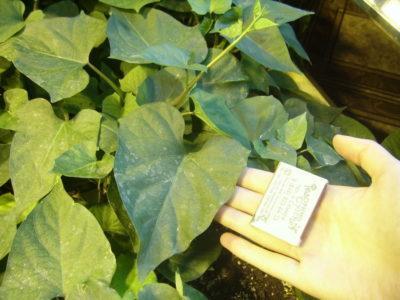

rodents;- bear;
- slugs;
- wireworms.
Disease manifestations: decay of foliage, tubers and roots, drying out of the plant.
Control measures:
- soil cultivation with wood ash, tobacco dust;
- collecting slugs by hand;
- installation of ultrasonic devices from rodents, planting buckwheat crops and tomatoes next to the sweet potato;
- filling the holes with buckwheat powder before planting.
Prevention of the appearance of various problems
- Compliance with the rules of crop rotation, planting sweet potato tubers in their original place no earlier than after 3 years.
- Keeping the soil moist.
- Support of daylight hours for sweet potatoes at least 8 hours (fluorescent lamps).
- Soil cultivation with wood ash, tobacco dust.
- Regular weeding and loosening of the soil.
- Weed removal.
- Compliance with the rules for storing tubers.
How to give to children?
From the age of three, sweet potatoes can partially replace potatoes... It is not recommended to cook sweet potatoes at the same time with other starchy and carbohydrate crops and foods (potatoes, bread, pasta, baked goods, corn). It is preferable to prepare children's meals with baked or blanched sweet potatoes in combination with tomatoes, pumpkin, herbs and fish.
Attention! You can eat sweet potatoes for children no more than 500 grams 2-3 times a week.
Sweet potato is a large group of edible crop varieties with a huge taste and appearance. Sweet potato tubers are strong, large, fleshy and have a pleasant taste. Unpretentiousness with high yields and a short growth period contributed to the spread of sweet potatoes in territories with different climatic conditions, and its rich mineral and vitamin composition allows it to be used as an ingredient in a mass of nutritious healthy dishes.
What is the difference between sweet potatoes and potatoes, Jerusalem artichoke and yam?
Since sweet potatoes are most often called sweet potatoes, it will be difficult for an unprepared tourist, being in an exotic vegetable market, to distinguish a vegetable from other similar plant tubers.
| Photo and title | Appearance | Taste and calorie content | Application |
| Sweet potato
|
|
|
|
| Potatoes
|
|
|
|
| Jerusalem artichoke
|
|
|
|
| Yam
|
|
|
|
According to the purpose of application and purpose, sweet potatoes are divided into the following types:
- vegetable;
- dessert;
- stern.
| View | Features of the | Popular varieties |
| Vegetable |
|
|
| Dessert |
|
|
| Stern |
|
Organic Sweet Potatoes
Sweet potato is the most environmentally friendly vegetable in Ukraine! During the cultivation of seedlings, planting in open ground, excavation of crops and storage, it is not processed with any pesticides, therefore, it can be safely attributed to organic products! But, of course, in some cases, for prevention, treatment with a solution of potassium permanganate or biological products is possible.
Colorado potato beetle, cruciferous flea, aphids, late blight - diseases and pests from nightmares that can destroy the plant and deprive us of the harvest of traditionally cultivated crops! They are not scary for sweet potatoes, but it should be noted that, like any crop, ordinary pests can slightly damage it.
Therefore, you need to monitor the fauna in the garden, and, if necessary, carry out prevention. For example, if the land is infected with a wireworm (drotyanka), then it is imperative to take measures: sow mustard for several years and embed it in the ground. But in most cases, the intensity and strength of growth 100% compensate for any damage from the pests.
Sweet potatoes are bred by seedlings, sprouting from a germinated root vegetable, which prevents degeneration and minimizes transmission of infections. That is, from year to year you keep the seed fund, which has tremendous productivity. For example, for planting 100 bushes, only 3 small root crops are enough.
And most importantly, sweet potatoes have a high yield - 3-4 kg per bush, sometimes just unrealistic 5-6 kg, and one specimen can weigh 2 kg. Someone will consider this breeding method a disadvantage, but the advantages clearly outweigh, all the more, growing sweet potato seedlings is very simple (unlike tomatoes, peppers), requires a minimum of effort, is entertaining and pleasing to the eye.
Yam root vegetables
Sweet potatoes - sprouted queen cells
Separated cuttings
Sweet potato harvest
If you use mulching (straw, agrofibre, film), then watering can be minimized! When the solar activity goes off scale, and the garden plants literally burn out, the sweet potato thrives. It will be noted that bountiful harvests can be obtained only with irrigation, since during prolonged drought, roots waste the accumulated moisture.
And if you are lucky and you live in the south and the weather gives you warm days, this should have a positive effect on the future harvest! There are times when the sun roasts at 40 degrees, in which case more nutrients are consumed for the life of the plant than usual, and there is a risk of nutritional deficiency (starvation) in sweet potatoes. It is imperative to fertilize the soil well before planting (compost, humus, ash), because sweet potatoes are very fond of organic matter.
Sweet potato planted under agrofibre
Sweet potato loves the heat
There is no unified varietal classification in the world, let alone Ukraine. In America it is one, in China it is different. The aboveground part differs in the structure of the bush, there are spreading and bush varieties. The leaf shape is heart-shaped or maple-shaped, with varying degrees of dissection. In addition to table varieties, there are many decorative ones.
The peel is pink, yellow, cream, orange, purple. The taste and benefits depend on the color of the pulp. White and cream traditional. Orange flesh, most often sweet, fruity and rich in beta-carotene.Purple, not at all sweet, close to the taste of potatoes, is rich in anthocyanins - antioxidants useful for vision, preventing aging and the development of cancer.
Skin color
Pulp color
Root crop shape
As for cooking, it can be fried, baked, steamed, mashed, added to soups and borscht, added raw to salads or simply gnawed, read the detailed article - recipes for simple sweet potato dishes. In addition, there are many delicious recipes to try! It is worth saying that each person has his own perception of the world, in particular food.
In some cases, sweet potatoes do not taste good because they are perceived as ordinary potatoes. It happens that, out of habit, against the background of many years of using traditional potatoes, it may seem sugary. But as soon as you eat it for several months, everything will fall into place. In addition, the farm uses the aboveground part, which gives abundant green mass by the time of harvest!
Sweet potato puree
Baked sweet potato in the oven
Fried sweet potato mix
Benefits and composition
Sweet potato is one of the healthiest vegetables in the world. Contains a large amount of potassium (K) and antioxidants (in orange and purple varieties), as well as B vitamins (B1, B2, B3, B6, folic acid), iron (Fe,) phosphorus (Ph), calcium (Ca), magnesium (Mg), vitamins A and C. Sweet potatoes are loaded with complex carbohydrates and fiber.
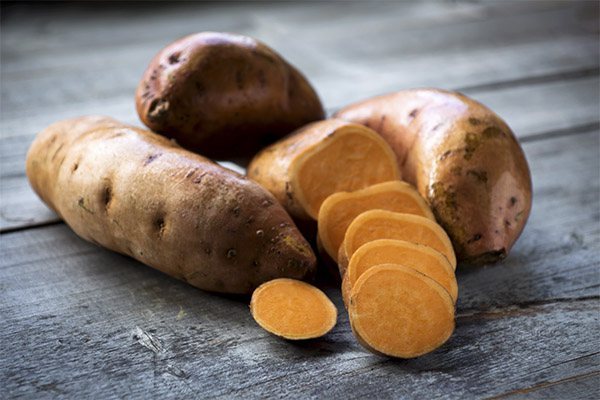

Just a godsend for diabetics, as it has a low glycemic index. Nutritious and satisfying, especially recommended for athletes and bodybuilders before training, as it provides slow-release energy. Does not give heaviness in the stomach, much easier to digest than traditional potatoes.
Delicate fiber helps with digestive upset and should be consumed by those who cannot tolerate regular vegetables. Recommended for pregnant women, nursing mothers and children. It also improves immunity, regulates blood pressure, relieves stress, is good for vision, slows down the aging process! The value of this vegetable can hardly be overestimated.
Purple is rich in anthocyanins
Orange is rich in beta-carotene
Storage
Sweet potato is a dull culture, it is well stored in room conditions (especially if a treatment procedure is carried out) at a temperature of 10-20 degrees Celsius (it dies below, germinates higher). For some unknown reason, many consider this to be the main drawback and the reason for refusing to grow this wonderful crop! Maybe it's a matter of habit that carrots, beets and potatoes are stored in cellars, basements at temperatures close to zero.
Sweet potatoes, in spite of their impressive size and mighty shape, are a very delicate vegetable and require a more reverent attitude towards themselves, but they will thank you in full for this! I think everyone can find a cool place at home! And someone will not have to look, because the floor has the right temperature.
Sweet potatoes, queen cells on the bed
It is worth making a reservation, many perceive sweet potatoes as a traditional potato, and even call it sweet potatoes, this is more familiar to the fish soup, but not entirely true, because they are fundamentally different vegetables! Root crops are habitually called tubers, but in fact they are thickening of the roots, and instead of eyes (like potatoes) - dormant buds! Also, it is often confused with Jerusalem artichoke. In short, sweet potatoes are not potatoes, but they can replace them in many dishes!
Traditional potatoes
Sweet potato
All people know what ordinary potatoes are. The tubers have a round irregular shape with eyes and various cracks. The flesh of the vegetable is much lighter than the peel. Potatoes are not eaten raw: this can lead to health problems. The sweet potato bears similarities to potatoes, especially the red varieties.
The main distinguishing feature of sweet potatoes from potatoes is the ability to eat it raw without harming the body.In principle, sweet potatoes are prepared in the same way as the well-known potatoes.


